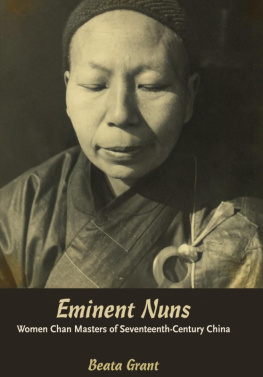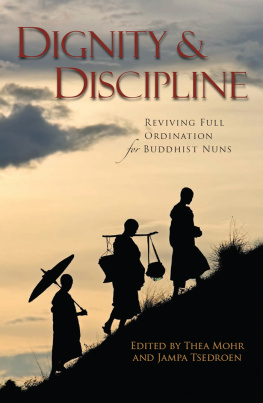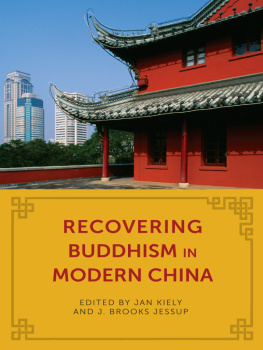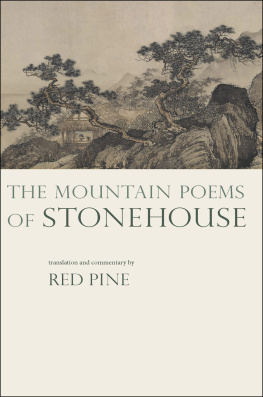
DAUGHTERS OF EMPTINESS

The incense in the Han halls has dispersed,
the blue birds are gone,
In the autumn chill of the Hou Mountains
the jade pipes grow faint.
In the ashes I can make out the remnants
of sadness and sorrow,
As alone I face the human world,
wrapped in the robes of a nun.
Jingwei, in seventeenth-century China
Women played major roles in the history of Buddhist China, but given the scarcity of the remaining records, their voices have all but faded. In Daughters of Emptiness, Beata Grant renders a great service by recovering and translating the enchanting verse by turns assertive, observant, devout of forty-eight nuns from sixteen centuries of imperial China. This selection of poems, along with the brief biographical accounts that accompany them, affords readers a glimpse into the extraordinary diversity and sometimes startling richness of these womens lives.
Beata Grants deft and elegant translations, together with her informative introduction and the brief biographies she provides for each of her judiciously selected poets, disclose fascinating but hitherto concealed or ignored dimensions of Chinese womens spirituality and literary creativity.
Professor Robert M. Gimello, Harvard University
A landmark collection of exquisite poems scrupulously gathered and translated by Beata Grant. Grant provides an impressively compact and readable overview of the changing fortunes of Buddhist nuns in China, from the fourth century to the present.
Buddhadharma
BEATA GRANT is Professor of Chinese Language and Literature at Washington University in St. Louis, Missouri. She is the author of Eminent Nuns: Women Chan Masters of Seventeenth-Century China.
TABLE OF CONTENTS
Table of Contents
Guide
PREFACE
BUDDHIST POETRY CONSTITUTES an important, although often undervalued, tributary of the Chinese poetic tradition: anthologies and other sorts of collections often included the works of monk-poets such as Hanshan and Jiaoran of the Tang dynasty (ca. 618ca. 907) as well as the Buddhist-inspired verse of many of the great poets of the tradition, such as the Tang dynasty poets Wang Wei and Po Juyi and the Song dynasty poet Su Shi (ca. 1037ca. 1101). Less known, however, is the fact that there were also a significant number of poet-nuns as well as ordinary laywomen who wrote Buddhist-inspired verse. They were by no means numerous: if the idea of men becoming monks and abandoning their familial responsibilities was never fully accepted in Confucian China, the notion of women becoming nuns and failing to fulfill their procreative duties or, as the case might be, leaving the protective shelter of fathers, husbands, or sons, was looked upon with even less favor. Still, whether due to warfare and displacement, difficult personal or financial circumstances, or simply determined religious aspiration, many women did become daughters of emptiness. And, as this selection of translations demonstrates, many of them did write poetry; and some of them wrote very good poetry indeed.
Poems by Buddhist nuns are to be found scattered in various different sources; a very, very few in collections of their own, somewhat more in anthologies of womens poetry, and many others embedded in biographical and other sorts of anecdotal and historical accounts. None are available in the annotated editions that have often been compiled for their more famous male counterparts. Lacking these editorial and scholarly supports, I have had to rely even more than usual on the generous advice and expertise of many colleagues and friends. First of all, I wish to express my appreciation to Professor Wilt L. Idema, who has been a wonderful mentor in the art of translation, and has consistently provided me with sometimes much-needed encouragement and support. I also owe a debt of gratitude to the late Professor John McCrae for encouraging me to rethink some of my translations and for clarifying my introduction, as well as to my colleague at Washington University, Professor Robert E. Hegel, who kindly read the introduction to this book and offered his usual succinct and insightful editorial advice. The editorial advice and moral support of these colleagues has been generous indeed; any errors of fact, translation, or interpretation remain, of course, mine alone. Last, but by no means least, I want to express my gratitude and admiration for the expertise and dedication of the editorial and production staff at Wisdom Publications: they have been a pleasure to work with from beginning to end.
I would like to dedicate this book to my parents, Robert and Carolyn Grant, who early on provided me with an abiding appreciation for the beauty and power of the written word, as well as with constant reminders of what Chinese Buddhist poets have always known: that which is of greatest importance often lies far beyond words.
Beata Grant
St. Louis, Missouri
INTRODUCTION
MANY WESTERN READERS are familiar with poetry written by Chinese Buddhist monks, perhaps the most famous of which is that collected under the name of the elusive Buddhist recluse Hanshan, or Cold Mountain.
Poetry writing assumes, of course, a fairly high degree of literacy. This is particularly true in the case of traditional Chinese poetry, which requires a mastery not only of the classical language but also, because of the frequent use of intertextual references and allusion, of the larger literary tradition, including poetry, history, and philosophy. This is one of the reasons why women poets are considerably less represented in the Chinese poetic tradition. In China, literacy and literature were traditionally looked upon largely as a means to an end, the end being not so much self-expression and aesthetic fulfillment as an official post in the imperial bureaucracy. Because women were excluded from this career goal, it was not considered vital indeed many felt it to be morally dangerous that they be provided more than a rudimentary education, if any at all.
Nevertheless, a significant number of women, mostly from elite families, of course, did manage to obtain the classical education that was necessary if they were to write. Such educated women writers can be found throughout the entire imperial period; one of the earliest was Ban Zhao (ca. 45116). For many women writers from the earlier periods we have only a handful of poems, or even just a single poem. From the seventeenth century and onward, however, we have significantly more poems by Chinese women writers: we know the titles of at least three thousand collections of poetry composed by women, one third of which are still preserved. This was due to momentous economic and social changes in Chinese society (which meant that more elite women were afforded education in the literary arts as well as the domestic ones) and to a veritable explosion in book-printing technology and publishing. Not surprisingly, we find the same pattern in the case of Buddhist nun-poets. Although the records contain the names of Buddhist nuns from the earlier periods of Chinese history known to have been highly educated and even famous for their literary talents, only rarely were any of their writings preserved. Of the many women of later periods whose writings have been collected and anthologized, there was also a small but significant number of Buddhist nuns. Indeed, many of these nuns had established reputations as cain, or talented women, even before they entered the religious life.
Next page







